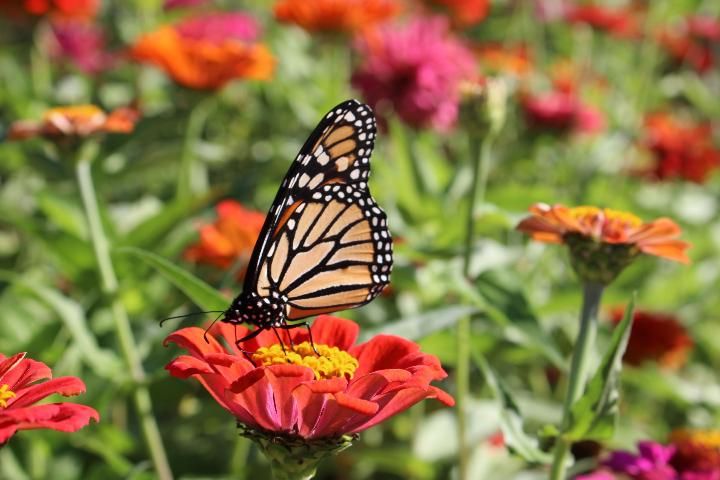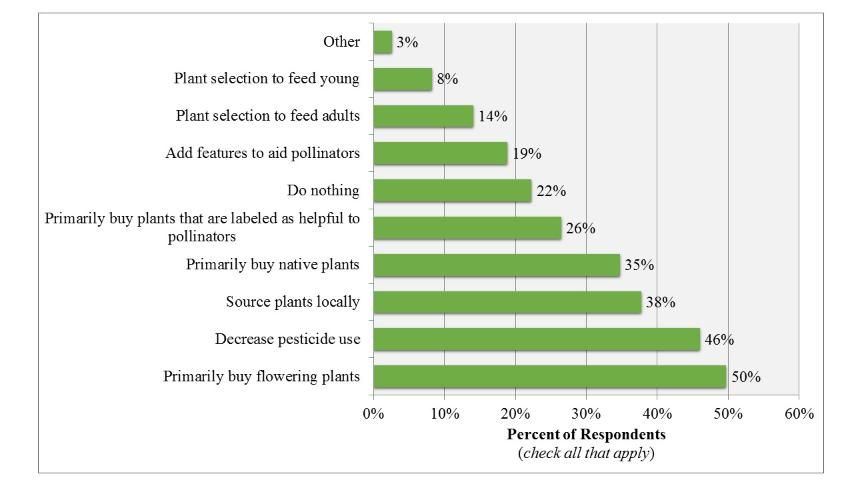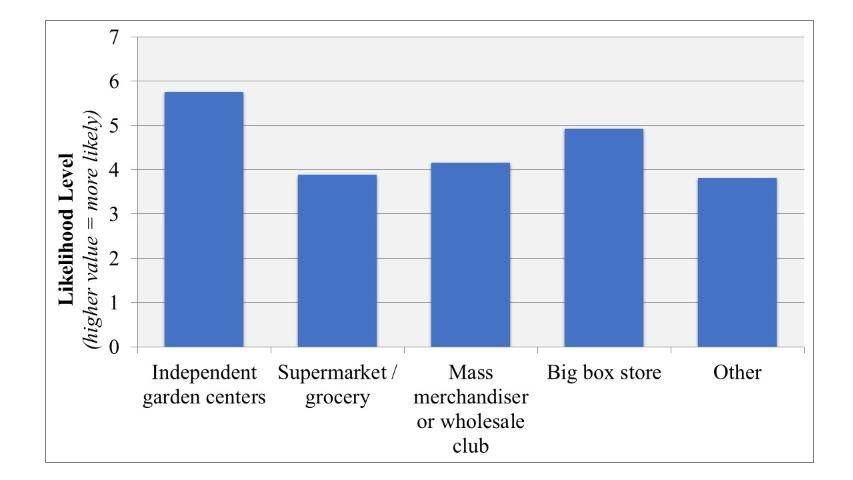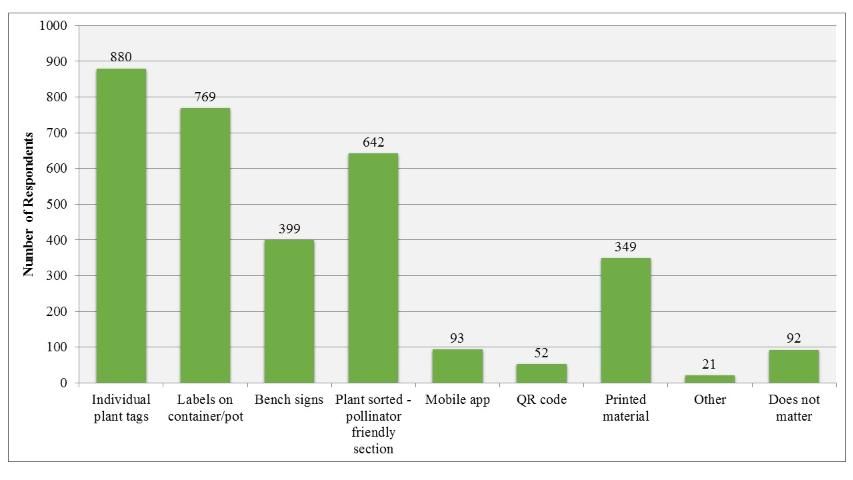Introduction
Recently, pollinator insects have received a great deal of publicity because their populations are declining. Pollinator insect population decline is very worrying because 70% of the world's food crop production depends upon pollinator insect services and producers would not meet the current and projected global need for food without them (Gallai et al. 2009; Klein et al. 20070). To date, research has primarily focused on factors contributing to pollinator population declines, including parasites, disease, pesticides, habitat loss, urbanization, nutrition, monoculture agriculture, and climate change (Fairbrother et al. 2014; Hanley et al. 2015). However, a subsection of habitat loss and urbanization that is often overlooked is homeowners or end-consumers and their preferences. Consumers are becoming increasingly important with regards to pollinator habitat loss because of urbanization given that 68 million US acres in 2012 were classified as "urban" (Cox 2012). Furthermore, 90 million US households (78% of all households) have yards, landscapes, or gardens that could be used to enhance pollinator habitat and health (Kiesling and Manning 2010). Consequently, consumers' actions could drastically impact pollinator insects.

Credit: USDA/NRCS SD15047
This report summarizes research findings from a University of Florida Institute of Food and Agricultural Sciences (UF/IFAS) study that focused on consumers' actions and perceptions as they considered ornamental plants that benefit pollinators. Understanding consumers' perceptions is important because those perceptions drastically impact product demand (Lusk et al. 2004). Using an online survey, UF/IFAS researchers collected a random sample of 1,243 US consumers in 2015. The sample was representative of US gardeners (National Gardening Association 2009) and included consumers from all 50 US states. The majority (73%) of respondents were from suburban and urban areas. All respondents were adults; their average age was 52 years old; there were more females than males (58% vs 42%); and about half (53%) indicated they were "avid gardeners." The following sections cover consumers' current actions to aid pollinators, their interest in purchasing plants that benefit pollinators, their perceptions about plant availability, and their preferences for in-store communications/promotions regarding plants that aid pollinator insects.
Current Actions to Aid Pollinator Insects
Many consumers are already taking actions to aid pollinator insects in their home landscapes. Fifty percent of consumers are consciously purchasing pollinator-friendly plants, and 46% are reducing the amount of pesticides they apply to their properties (Figure 1). Thirty-eight percent of consumers purchase local plants while 35% primarily buy native plants. Local and native plants are beneficial because locally produced plants increase food availability (i.e., nectar and pollen) while native plants have coevolved to benefit native pollinators. Additionally, pollinator insects often prefer native plants to exotic plants (Frankie et al. 2005). Twenty-six percent of consumers report they actively seek out plants labeled as beneficial to pollinator insects. Nineteen percent of consumers indicate they have added features (i.e., water sources, nesting/natural areas, butterfly houses, etc.) to their landscapes to benefit pollinator insects. Fourteen percent have selected plants to feed adult pollinator insects, and 8% have selected plants to feed juvenile (i.e., larval) pollinator insects. Three percent indicated "other." While 22% of consumers currently take no actions to aid pollinators in their home gardens and landscapes, 78% of consumers are actively trying to assist pollinators, indicating a potential market for plants that aid pollinator insects. To explore potential strategies for promoting plants as being beneficial to pollinators, the next section discusses consumers' interest in purchasing plants to aid pollinators.

Consumers' Interest in Purchasing Plants to Benefit Pollinator Insects
Purchasing intent is important because it can indicate market potential as well as overall consumer interest in different products and attributes. The majority of consumers (69%) in our sample reported that they are interested in purchasing ornamental plants that benefit pollinator insects (Figure 2). Only 9% are not at all interested in purchasing ornamental plants to aid pollinator insects, while 22% indicate indifference (neither interested nor not interested). These results imply there is potentially a large consumer segment that is aware of the problem facing pollinator insects and that wants to aid pollinators through their actions. There is also potential to sway the "indifferent" group through educational materials and promotions highlighting the problems associated with pollinator population declines (i.e., reduced food production, less biodiversity, etc.) and ways of countering these declines (i.e., landscape design, pollinator friendly plants/features, etc.).

Perceived Plant Availability, by Retail Outlet Type
Retail outlet type can greatly influence product availability and, ultimately, consumer purchasing behavior. For instance, consumers often perceive horticultural products purchased from independent specialty stores as being higher quality and more expensive than those available at mass retailers (Yue and Behe 2008). Furthermore, consumers tend to have different purchasing goals when visiting different retail outlets. Consumers purchase horticultural items intended as gifts for other people from specialty outlets (due to perceptions of higher quality) and horticultural items intended for themselves from mass retailers (Yue and Behe 2008). In the current study, consumers indicated that plants that benefit pollinators are most likely to be found at independent garden centers, followed by big box stores, mass merchandisers/wholesale club stores, supermarket/grocery stores, and other (e.g., farmers markets) (Figure 3). Consumers perceived independent garden centers to be the best retail outlet for pollinator-friendly plants because they perceived the independent stores as having a more diverse plant selection and knowledgeable staff, invaluable features for shoppers seeking plants to aid pollinator insects. Big box stores and mass merchandisers/wholesale club stores rated similarly high because those retail outlets tend to have garden centers that provide multiple product options and a large selection. Retail outlets carrying plants that benefit pollinators can potentially increase sales by promoting their pollinator-friendly plants and indicating which plants are beneficial, thereby educating uninformed consumers and making them aware of their options. The next section covers the best in-store promotion formats to use to communicate this benefit to consumers.

Consumers' Preferred In-Store Promotion Format
"Pollinator-friendly" is a credence attribute, meaning the attribute is not readily apparent to a potential customer from simply looking at the product. Therefore, consumers unfamiliar with plants and plant attributes that benefit pollinator insects sometimes rely on in-store promotions/communications and sales associates to inform them about which plants benefit pollinators. As a result, in-store promotions can influence product selection and consumer satisfaction. When asked the best means of communicating that a plant is beneficial to pollinator insects, consumers reported individual plant tags as the best in-store promotion format, followed by container/pot labels and sorting the plants into a "pollinator" section (Figure 4). Bench signs and other printed materials would also be effective ways to inform consumers about which plants benefit pollinators. Less desirable options include mobile apps and QR codes. A small number of respondents indicated that the communications method "does not matter."

Summary
Overall, US consumers are interested in taking actions that help pollinator insects. Currently, consumers' primary means of aiding pollinators is through purchasing beneficial plants, with 69% expressing an interest in purchasing these items. This implies that retailers could benefit from carrying plants for pollinators and promoting them within the retail setting, especially in independent garden centers and big box stores, because consumers expect these items to be available at those outlets. The best in-store promotions include individual plant tags, container labels, a pollinator plant section, and bench signs. In-store promotions allow consumers to make informed decisions as they shop for plants. In turn, greater awareness of plants that aid pollinators may have long-term beneficial effects on pollinator populations through greater product selection and availability of beneficial plants within urban landscapes.
References
Cox, W. 2012. "New US urban area data released." Retrieved from https://www.newgeography.com/content/002747-new-us-urban-area-data-released
Fairbrother, A., J. Purdy, T. Anderson, and R. Fell. 2014. "Risks of neonicotinoid insecticides to honeybees." Environmental Toxicology and Chemistry 33:719–731.
Frankie, G. W., R. W. Thorp, M. Schindler, J. Hermandez, B. Ertter, and M. Rizzardi. 2005. "Ecological patterns of bees and their host ornamental flowers in two northern California cities." Journal of Kansas Entomological Society 78:227–246.
Gallai, N., J. M. Salles, J. Settele, and B. E. Vaissiere. 2009. "Economic valuation of the vulnerability of world agriculture confronted with pollinator decline." Ecological Economics 68:810–821.
Hanley, N., T. D. Breeze, C. Ellis, and D. Goulson. 2015. "Measuring the economic value of pollination services: Principles, evidence, and knowledge gaps." Ecosystem Services 142:137–143.
Kiesling, F. M., and C. M. Manning. 2010. "How green is your thumb? Environmental gardening identity and ecological gardening practices." Journal of Environmental Psychology 30:315–327.
Klein, A. M., B. E. vaissiere, J. H. Cane, I. Steffan-Dewener, S. A. Cunningham, C. Kremen, and T. Tscharntke. 2007. "Importance of pollinators in changing landscapes for world crops." Proceedings of the Royal Society 274:303–313.
Lusk, J. L., L. O. House, C. Valli, S. R. Jaeger, M. Moore, J. L. Morrow, and W. B. Traill. 2004. "Effect of information about benefits of biotechnology on consumer acceptance of genetically modified food: Evidences from experimental auctions in the United States, England, and France." European Review of Agricultural Economics 31:179–204.
National Gardening Association. 2009. "The impact of home and community gardening in America." In The impact of home and community gardening in America, edited by B. Butterfield (1.17). South Burlington, VT: National Gardening Association.
Yue, C., and B. K. Behe. 2008. "Estimating US consumers' choice of floral retail outlets." HortScience 43(3):764–769.